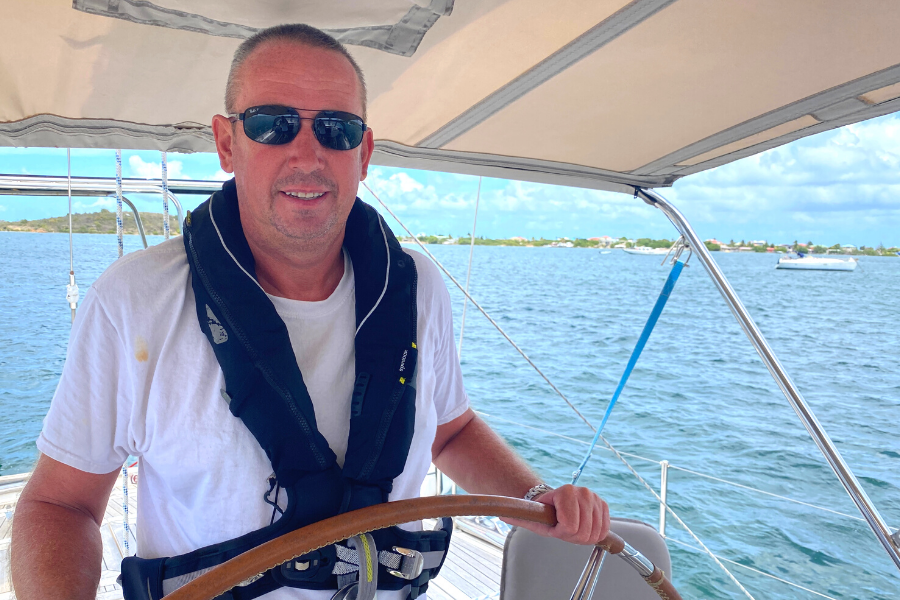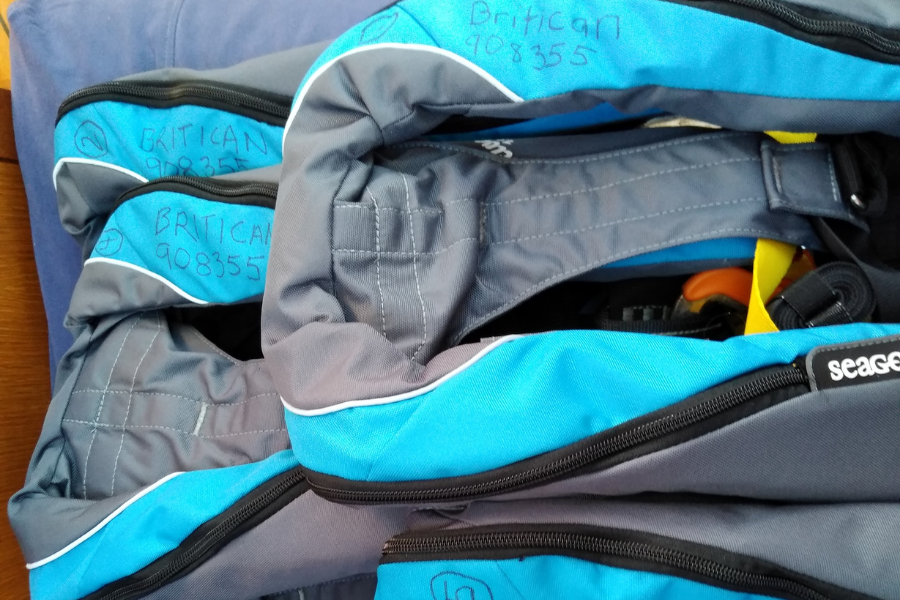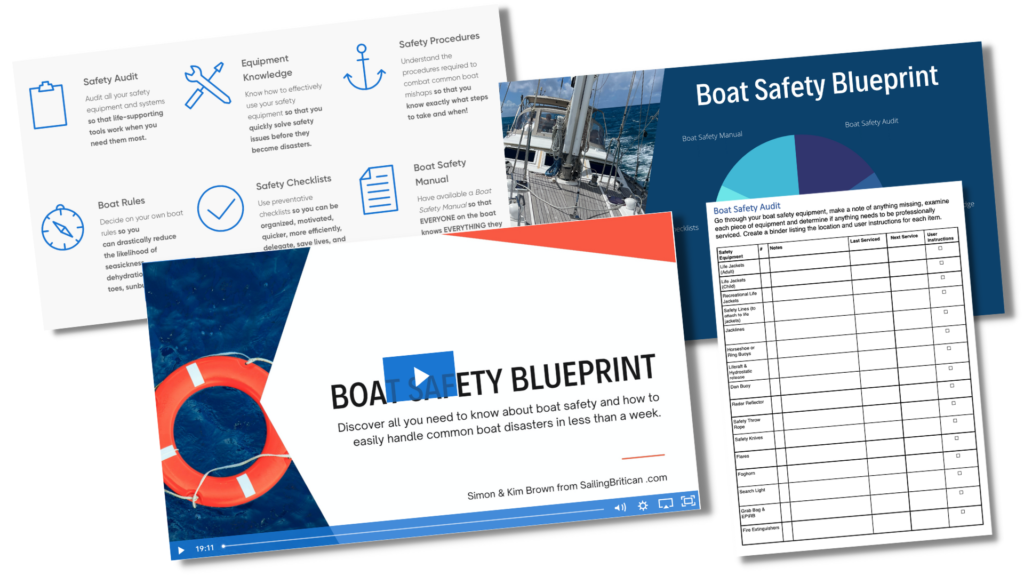The Best Life Jacket for Sailing Cruisers? Let me tell you a story first.
Never did I expect to be standing under the boom in a Force 10 storm trying to tie down our mainsail. The seas were an ominous muddy gray with enormous white angry cresting waves. The waves were crashing on top of a large and wide Atlantic swell off the coast of Morroco. Before heading to the foredeck, I was seasick. By the time I got to the mast and tied my harness on, the fear had forced my ill feelings into submission.
First, I dropped our sail. Then I realized that the sail would not stay down unless I tied it down. The wind was forcing the main back up the mast. Feeling terror, probably for the first time in my life, I diligently worked on getting a sail tie over the mainsail to strap it down to the boom.
That’s when it happened. That’s when I learned the value of a tether and life jacket. I reached up to grab a sail tie that I had tossed over the boom. My hand slipped and my entire upper body went flying back. I was on the coach roof under the boom, with my tether around the mast.
Looking down, my body hovered more horizontally than vertically.
My heart felt a violent surge of energy. I grabbed the tether and pulled myself back up to standing. If it wasn’t for the boat safety tether attached to my life jacket, I would have been in the sea.
Whenever it’s nighttime or we’re sailing through a storm, we all wear our life jackets on Britican. Being full-time cruisers, it’s impractical to wear them all the time. A big key to sourcing the best life jacket for sailing cruisers is to find one that is comfortable. Carry on reading to get my top tips but allow me to give you a general overview on life jackets first. In a future article, I provide further information and tips about tethers.

Life jackets for sailors
Life jackets come in a variety of sizes, makes, and models. They make inexpensive life jackets of thick floatation foam covered in a highly visual material. These types of life jackets rarely work very well to keep a person’s head out of the water, nor do they come with head protectors, lights, or harnesses. They are often large, bulky, and uncomfortable.
On the other side of the spectrum, the more expensive models are less cumbersome, often come with reflective hoods and ensure that a person’s head is kept above water. The more expensive life jackets trigger a gas chamber to fill air into the jacket upon impact on the water.
Most modern countries require that there is at least one life jacket for every person on board. That being said, cruising boats often have a few expensive life jackets for the crew or owners. And then a boat might have stock of the less expensive life jackets to ensure requirements are met when extra guests come aboard.
Although the more expensive life jackets are less bulky, they can be heavy around the neck and similarly uncomfortable.
Putting comfort and features aside, the key with a life jacket is to find one that will do the job and be worn. The worst-case scenario is that you’ll be knocked unconscious and fall overboard.
With that in mind find the best life jacket for cruisers, it’s imperative that it suits your weight and/or chest size. Next, make sure the life jacket is as comfortable as possible. There are a wide variety of jackets and considering that you may have to wear one for several hours it’s worth taking the time to find one that’s right for you.
General instructions for use
Once you have a life jacket that will do the job, it’s not just a matter of putting it on blindly or incorrectly! Before putting a life jacket on, you need to inspect it for any wear and tear. If the life jacket has been compromised, find an alternative. Also, if the life jacket has a gas chamber, inspect the chamber to ensure it’s in date or working. Many gas chambers have an indicator link notifying you of its status. If the gas chamber isn’t working your life jacket won’t inflate upon impact and becomes a hindrance rather than a lifesaver.
When putting the life jacket on, make sure it fits snuggly but isn’t too tight.
Zip all zips and use all ties – especially the strap that goes from back to front through your legs. Often, you’ll see sailing cruisers fail to use the crotch straps. If you’re thrown off the boat and the straps are not connected there is a chance that the impact will force the life jacket over your head and off your body.
The time to try a life jacket on and fit it to your size and shape of body is before you head out to sea. One of the first things we do with our new guests is to have them try on their life jacket, adjust the straps and have it ready for use if and when needed.

Legalities-Know Before You Go
Laws regarding the use of life jackets change from one country to another. In America, each State has its own boating laws but there is a Federal Law, covering all the States, requiring that when a vessel is underway, children under 13 years of age must wear their life jacket. There must also be enough life jackets aboard for the number of people on the boat.
Some States approve the inflatable jackets only if they’re worn. That means that if you’re not going to wear a life jacket you need to have approved life jackets at hand in addition to the inflatable type.
In the UK there is no legal requirement for anyone of any age to wear a life jacket. There is also no enforceable Law regarding having enough personal floatation devices (PFDs) onboard per passenger on any privately owned vessel regardless of its size.
Before you head out sailing, make sure you know the laws in the waters, you’re sailing in.
But what makes the best life jacket for sailing cruisers? It’s not necessarily the brand although some people find some brands more comfortable and easier to wear. Let’s cover some specific tips for sailing cruisers.
The Best Life Jacket for Sailing Cruisers – 7 Must-Know Tips
Tip #1: Number your life jackets.
It’s often a good idea to put a name and/or number on each of your life jackets. Both Simon and I have the same life jacket, but I can quickly see my name written on the inside collar. Often, I’m putting my life jacket on because of a squall and I need to be quick. Picking the life jacket with my name on it helps me to avoid putting on the wrongly sized jacket.
All our other life jackets have a number. When guests come aboard with give them the best life jacket to do the job and have them fit it to their body for use during their stay. We have adult,
Tip #2: Store all life jackets in the same place.
All our life jackets are located under our navigation station seat. If possible, you want to keep them all in one place so they’re easy to get to. During a passage, however, we pull them out and store them in our berth when we’re not wearing them and ask our guests to do the same—otherwise, they clutter up the cockpit or saloon or get misplaced.
Tip #3: Try before you buy.
Just because a life jacket has all the bells and whistles doesn’t mean that it’s good. Try them on. I can’t tell you how many uncomfortable night watches I’ve had because I told Simon to, ‘get me whatever life jacket that’s out there!’ The first high-priced life jacket I had was so heavy around my neck that I was in serious discomfort. Doing night watches can bore at best. Having a heavy thing around your neck only makes it worse. You don’t want to make wearing a life jacket painful!
Tip #4: Don’t buy where you try.
When you’re getting ready to buy life jackets, go to a local boat store, chandlery, or boat show and try on as many as possible. When you find what you like, check online boat stores as the same make and model is usually less expensive.
Keep in mind that there are different performance types, performance levels, and weight categories. Cruisers need to get a life jacket that is Type 1 which has the greatest required inherent buoyancy and turns most unconscious persons from a face down to a vertical/backward position. The performance level should be intended for offshore sailing. And weight categories include an infant (>33 lbs.), child (< 33 lbs.), Youth (<55 lbs.), and adult (< 88 lbs.)
Tip #5: Consider having a life jacket policy.
On Britican, we’ve made it mandatory to always wear a life jacket during night watches. It’s also mandatory during big storms – especially if any of us are required to go to the foredeck or outside the cockpit. Furthermore, all children must wear a life jacket if they’re going to leave the cockpit. And young ones must be accompanied by an adult.
Tip #6: Keep a safety checklist.
Make sure you have a boat safety checklist outlining all of your safety equipment, where it’s located on the boat, and when it next needs to be serviced. Every year we have all of our life jackets professionally tested. The gas chambers are examined; the life jackets are inflated, and they’re left overnight to ensure they’re holding air.
Tip #7: Have spare flotation devices for children.
For children, it’s important to take your time finding a comfortable life jacket. You don’t want your life to turn to hell every time you need to get little Johnny to put his life jacket on. While our daughter was growing up, we always had the appropriate and highest-rated life jacket for her age. We also had recreational life jackets that were less cumbersome and easier to wear.
When anchored we put our daughter in the recreational life jacket. This made it easier for all of us to ensure she had some protection. Furthermore, we made sure that she had swimming lessons every day of her life! It wasn’t until she could swim that I relaxed a bit and allowed her some freedom on the deck.

So, the best life jacket for sailing cruisers isn’t one particular make or model of jacket – it’s the right jacket for the person wearing it.
The life jacket is just one of the important aspects of boat safety. Make sure to understand all the boat safety kit, where it is, how it works and when it needs to be serviced and maintained.
Make Sure Your SAFE Before Heading Out To Sea!
Watch our Boat Safety Blueprint Video and get a copy of our Boat Safety Audit checklist. Request access here: Boat Safety Blueprint & Audit
Also, check out a handy PDF provided by the USCG. It outlines all the different types of life jackets (PDF): How To Choose The Right Life Jacket
Make sure to sign up for our weekly updates and newsletter. I’ll be writing more about the safety kit for sailing cruisers. Don’t reinvent the wheel or make the mistakes we did. Learn from our learning curve so you can hit the ground running.

Best to have a PLB For location etc If overboard and an attachment for looping rope. It’s very difficult to get back into the boat from the water…a halyard attached on a mechanical pulley is a lot easier!!
Great advice. Thank you, Arty. Kim
I am not impressed with the comment “dont buy where you try”…..your advice to go to a chandlers and waste their time and put wear and tear on their products and then abandon them to a cheaper website is why those chandlers will eventually be put out of business…..If I go to a store and the store employees help me with knowledge, actual hands on tryouts and more…the least I can do to repay that is to buy at their store…….enough of the online is cheaper…..it is not…we are eventually going to pay with the loss of local knowledge that chandlers usually hand out free…
Derrick – you obviously haven’t shopped at too many boat chandleries. The mark-up at places like West Marine is often 1000x more than an alternative source. If they provided products at a reasonable price I’d agree with you. I’m not into wasting people’s time, but I’m not going to pay way over the odds when I don’t have to. K.
West Marine Pricing is ridiculously high. I do not get it lower prices and stop closing stores.
Only in dire emergency and usually have to order, in case you need a new T Shirt
Yeah…I agree that West Marine is nuts!
I heartily concur.
Hi, thanks for sharing advice and promoting the community!
You have the less-than switched in the article.
Also, I am personally for supporting local businesses including bricks-and-mortar stores in addition to buying on Amazon every day :-). I’d rather see promotion of trying at a store but also buying there even if it is a bit more expensive. If they don’t survive there are less places to try at..,